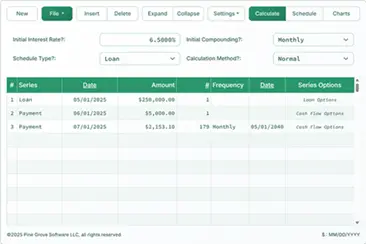How To Calculate a Balloon Amount
To set your preferred currency and date format, click the “$ : MM/DD/YYYY” link in the lower right corner of any calculator.
A Step-by-Step Tutorial
Tutorial 7
Calculate the balloon payment for a mortgage or loan that becomes due after a series of regular payments. If the regular periodic payment is not large enough to fully amortize the loan over the scheduled term, then the final payment will be larger than the others. This larger, final payment is called a balloon payment. This tutorial explains how to set up the calculator to solve this type of financial problem.
Note: The questions “What is the balloon payment at period 48?” and “What is the remaining balance at period 48?” have different meanings. A financial calculator should return different results for each question. The first question asks for the payment due at period 48, including all interest that has accrued. The second asks for the remaining balance after the payment at period 48 has been made, with no further interest added. Many online financial calculators incorrectly treat these two values as the same.
Before starting this tutorial, all users should complete the more detailed initial tutorial. It explains the UFC’s basic concepts and settings.
To create a loan schedule when the balloon payment amount is unknown, follow these steps:
- Set Schedule Type to Loan.
- Alternatively, click to clear any existing entries.
- Click , then select . Set “Rounding” to Open balance — no adjustment.
- In the header section, apply the following settings:
- Select Normal for Calculation Method.
- Set Initial Compounding to Monthly.
- Enter 6.75 for Initial Interest Rate.
- In row 1 of the cash-flow input area, create a “Loan” series.
- Set the “Date” to July 1, 2020.
- Set the “Amount” to 365,000.00.
- Set “# Periods” to 1.
- Note: Because the number of periods is 1, you will not be able to set a frequency. If a frequency is entered, it will be cleared when you exit the row.
- In row 2 of the cash-flow input area, select “Payment” for the “Series” type. In this example, you will create a schedule for a mortgage that includes a balloon payment due after 5 years (at the 60th monthly payment). The monthly payment will be calculated as if the loan were amortized over 30 years (360 monthly payments).
- Set the “Date” to August 1, 2020.
- Set the “Amount” to “Unknown” by typing U.
- Set “# Periods” to 360. This causes the calculator to compute the payment amount as if the loan had a 30-year amortization schedule.

- Click . The result is $2,367.38.

- Calculate the final balloon payment amount.
- Change “# Periods” in the second row from 360 to 60.
- In row 3 of the cash-flow input area, select “Payment” for the “Series” type.
- If not already set, enter the “Date” as August 1, 2025 (the end of the 5th year).
- Set the “Amount” to “Unknown” by typing U.
- Set “# Periods” to 1.

- Click . The balloon payment due will be $344,573.94.

- To view a detailed amortization schedule that shows the monthly allocation to principal and interest and the final balloon payment amount, click on the button bar.

- To view a chart of the balloon-payment loan, click .

Variation: Instead of using the calculator to compute the payment amount, you may enter your own. In the first calculation step, input your preferred payment amount instead of “Unknown”. Set the number of payments to 60. Then skip to step 7 to calculate the balloon payment.

The Ultimate Financial Calculator can calculate a loan’s balloon payment when one is required. It supports complex cash-flow structures with variable payments and interest rates. Be cautious when comparing results with other financial calculators. Many incorrectly treat the remaining balance as the balloon payment. This is not accurate.
Back to the Ultimate Financial Calculator.
